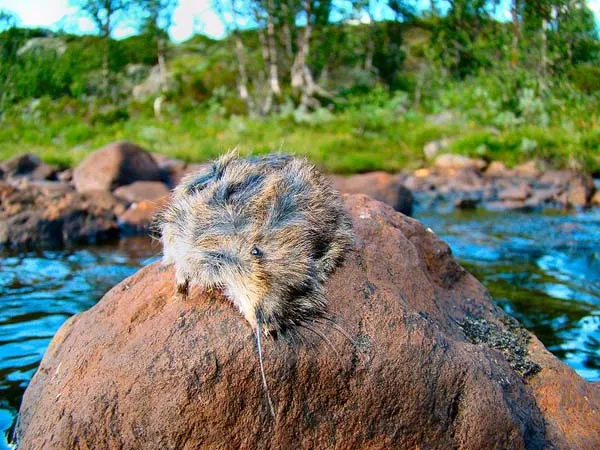It’s an enduring image: thousands of lemmings, mindlessly following each other over the cliff to their deaths.
Ornithologist Joe Smith’s popular blog on Cool Green Science this week focused on how lemmings shape nearly every aspect of arctic habitats. They may well be behind the snowy owl invasion occurring in the eastern United States, and lemming populations affect other wildlife from foxes to geese.
But of the many amazing lemming facts Smith described, he didn’t include lemmings leaping off cliffs. For good reason: it isn’t true. Lemmings do not commit suicide.
How did such a fantastical story originate?
As with many myths and tall tales, it is perhaps loosely rooted in real events. As Smith writes, lemmings do have population fluctuations. When lemmings are super-abundant, there will be carnage: predators take advantage of the easy food source, as shown dramatically with the owl nest lined with 70 lemmings.
Lemmings will also migrate when their populations are high. This may entail crossing rivers and streams, and invariably some drown.
I’ve witnessed population explosions of voles, another small rodent. Hawks, owls, foxes, coyotes and snakes dine frenetically on the abundant mammals. Many fall into streams and drown (or are eaten by trout). There are dead voles and bits of voles littering the ground.
It’s much the same for lemmings (or Serengeti wildebeest or spawning salmon or any other large congregation of prey).
Early observers likely noted super-abundant lemmings and saw many dead ones littering land and water. They may have even seen some that had slipped off cliffs. They created stories to explain these happenings.
As early as the 1500s, people told of lemmings raining from the sky. (Such stories may seem fanciful to us, but at the time they were considered scientific. Some scientists, for instance, once believed birds hibernated under ground in the winter, not understanding migration).
The lemming stories remained in the realm of folklore for centuries. Then came a 1958 Disney movie, White Wilderness. It included a remarkable bit of lemming migration footage, including lots of the rodents plunging off a cliff:
The movie won an Academy Award for Best Documentary. It also convinced moviegoers that, when lemming populations grow too high, they migrate and commit suicide en masse
While the movie may now appear outdated and grainy, that sticky idea has lasted.
The problem is, the footage is fake.
The problem is, the footage is fake.
It’s now well documented that this was not a migration at all; the segment was filmed in Alberta, far from the lemming’s arctic realm.
The film crew placed a relatively small number of lemmings on a turntable. This created the illusion of large numbers of animals roaming the habitat, when in reality it was the same animals repeatedly passing by the camera.
The unfortunate lemmings were then herded over a cliff and into the water below – creating the movie’s most dramatic scene.
Today, it seems like nothing more than an exercise in animal cruelty.
Still, the facts haven’t mattered for the lemming’s public image.
To call someone a lemming is to suggest he or she is a blind follower. Politicians love to use the term, often to describe the opposing party. Lemmings are still invoked in songs, cartoons, films and other popular media, always in a derogatory manner.
And so, for generations people have accepted and repeated a movie fiction as fact, this despite considerable biological research on lemmings and their arctic ecosystems. In the end, it would appear it is not the lemming who deserves the reputation for “mindlessly following.”




Oh the things we ponder. Yet had I not read this, I still would’ve been envisioning this, never before known falsity, with subdued amazement, very glad I’m not a lemming.
Matt, I do enjoy reading your blogs, when I take the time to do so! Thanks.
Fantastic piece Matt …. Amazing the myths that Disney has perpetuated over the years. They are also past masters at anthropomorphic tales that have a tendency to cause wildlife more harm than helping. Think feeding “cute and cuddly” wolves and bears and habituating them to humans and their food and it never seems to end well for the wildlife. If I ever get back up to the arctic to fish I will have to have someone tie some lemming flies for me 🙂